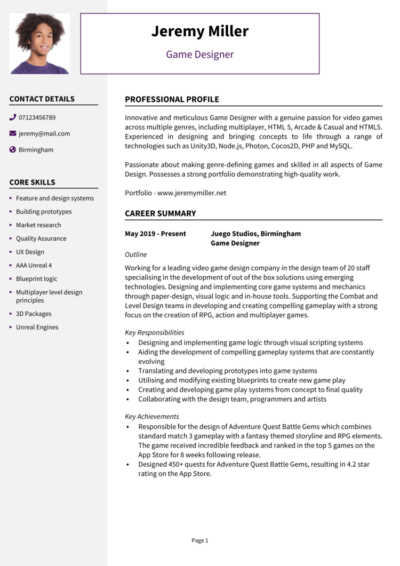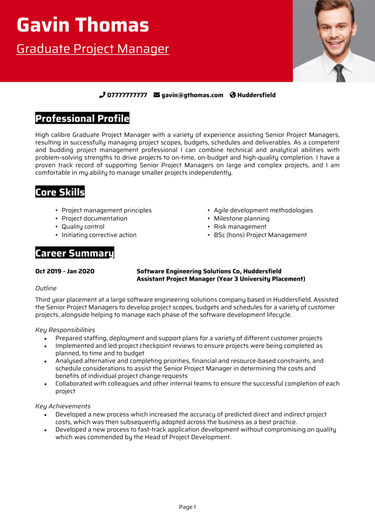You’ve built entire worlds and brought ideas to life – but now it’s time to tackle the final boss: your CV. Your game design CV needs to showcase your creative spark and your technical precision if it hopes to win over hiring managers.
Use this guide and its Game Design CV examples to help present your skills, experience, and passion in a clear and structured way – so you can impress studios with more than just your gameplay.
Game Designer CV example
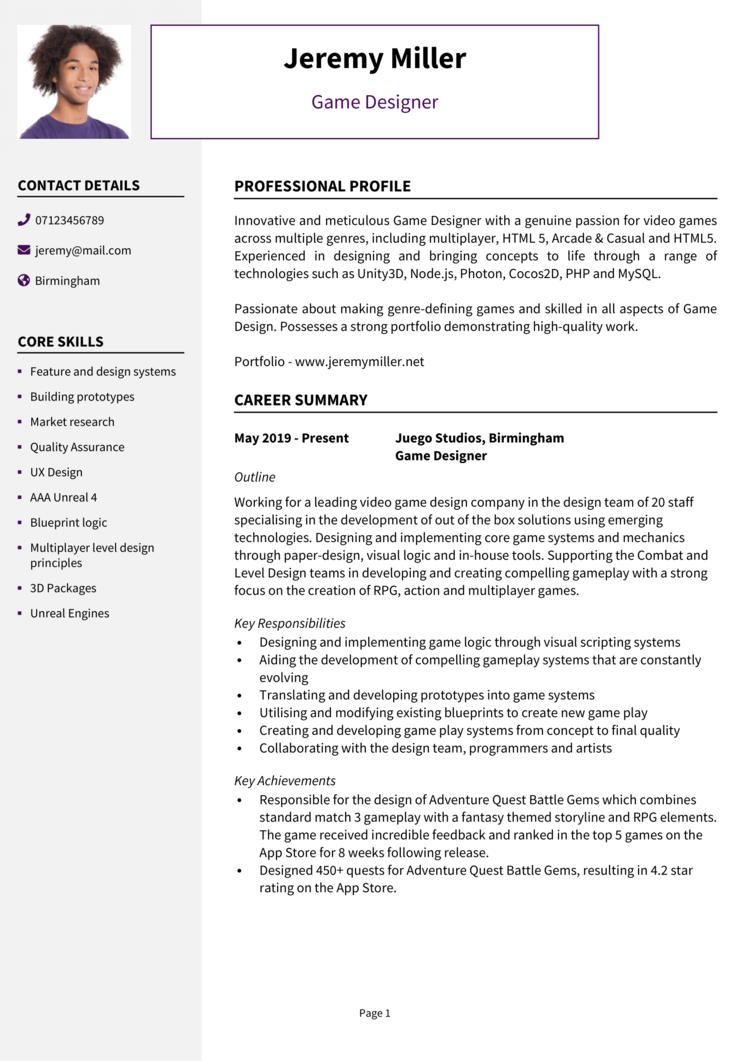
Game Artist CV example
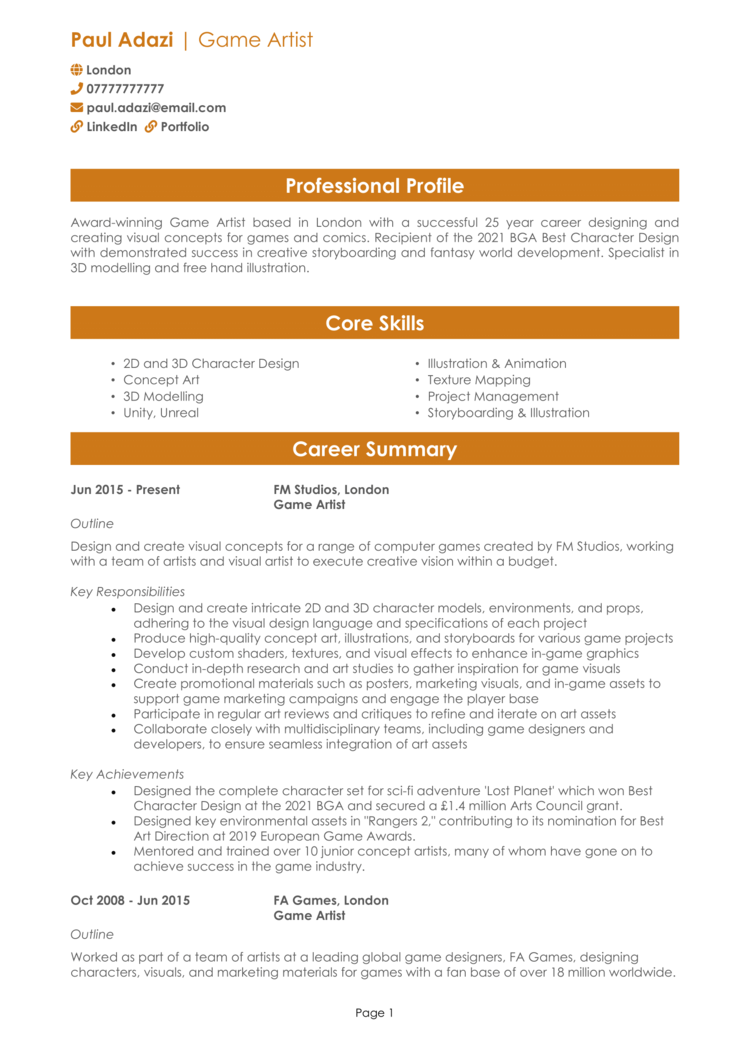
How to write your Game Design CV
Discover how to craft a winning Game Design CV that lands interviews with this simple step-by-step guide.
Game designers do more than just dream up ideas – they refine, prototype, and collaborate to make those ideas playable. Your CV should mirror that mindset: a carefully crafted document that communicates both your creativity and your reliability.
This guide will walk you through how to write your CV, what to include, and how to showcase your game design experience so studios and employers take notice – whether you’re a junior looking for your first break or a seasoned dev ready for your next project.
Game Design CV format and structure guidelines
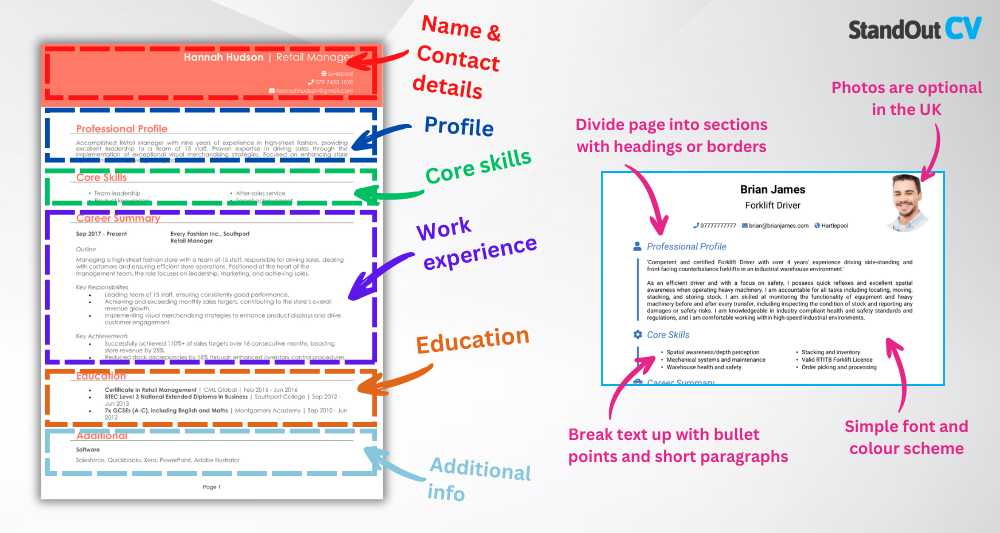
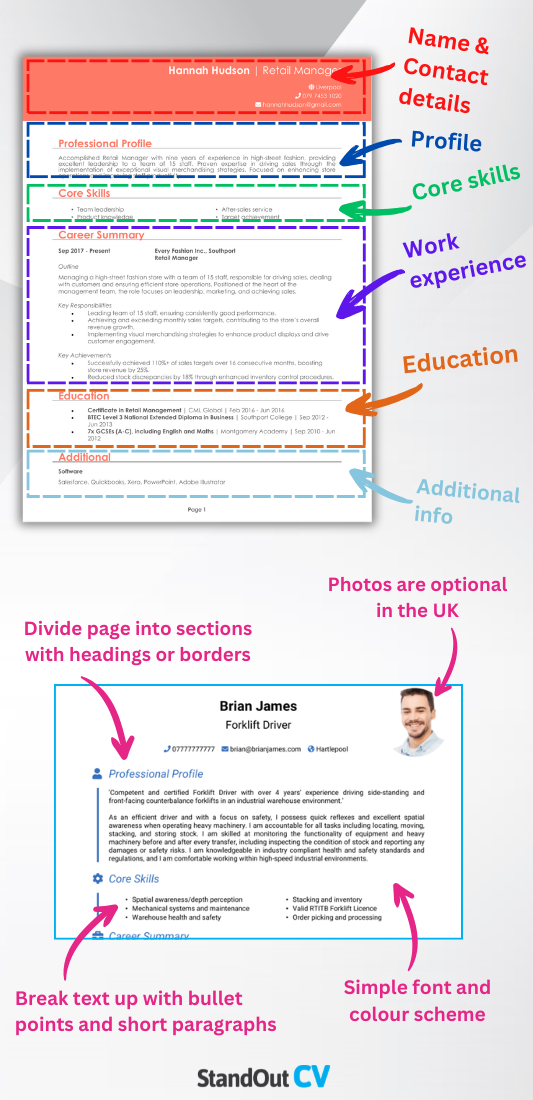
A clear structure helps present your ideas in a way that feels cohesive and considered – just like any good design document. Think of each section like a new level, with consistent formatting as your UI and bullet points as your tooltips. If your layout is cluttered, inconsistent, or hard to read, it will distract from your actual value – so aim for a layout that supports your content without stealing the spotlight.
Here’s the layout to follow:
- Name and contact details – Place your name and personal details prominently at the top of your CV for quick access. Adding a photo is up to you.
- Profile – Give a short paragraph summarising your design focus, experience, and career goals.
- Core skills – Bullet points highlighting your strongest tools, methods, and areas of expertise.
- Work experience – List your roles in reverse chronological order, focusing on game dev involvement.
- Education & certifications – Provide details on your academic background, including certifications or specialised training.
- Additional info – Optionally add personal game projects, game jams, portfolio links, and related hobbies.
Stick to a two-page length limit, use bullet points for clarity, divide each section with clear headings, and choose a font that keeps your CV looking clean and professional. Your CV format should feel more like a polished UI and less like a cluttered debug screen: recruiters don’t spend long reading your CV, so keep it readable and mistake-free if you want them to stick around.
Creating a strong Game Design profile
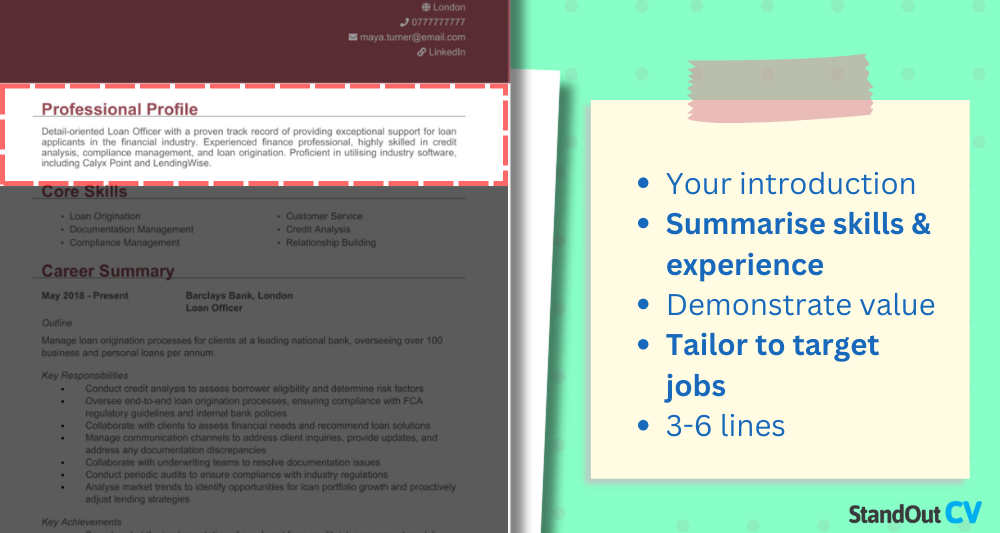
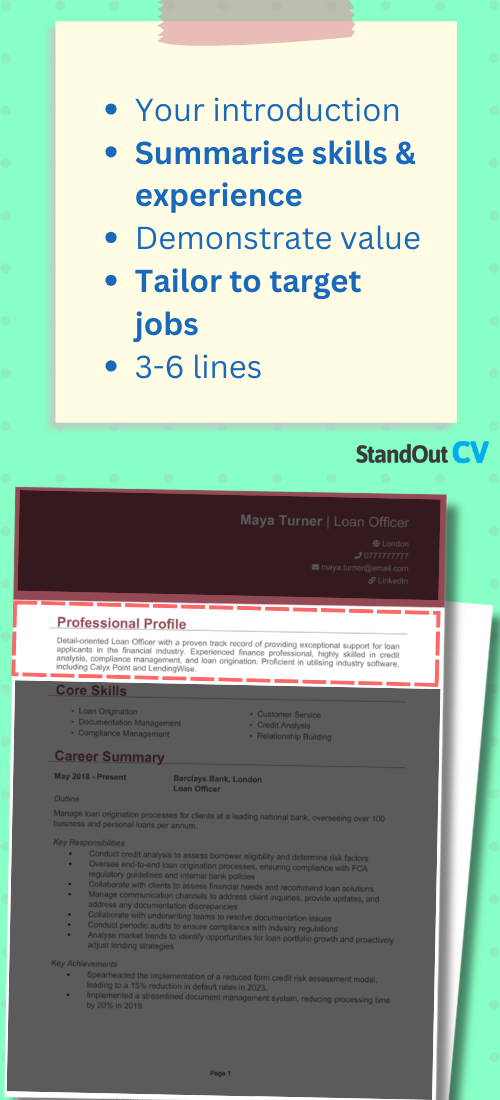
Your CV profile isn’t just a warm-up – it’s your elevator pitch, and one of the first things a hiring manager will read. Instead of trying to list everything you’ve ever done, focus on showing what kind of designer you are and what excites you about the work you do.
It’s also where you highlight your niche. Whether you’re systems-focused, narrative-driven, or somewhere in between, this is your chance to communicate the themes and approaches that define your design style – without needing a 10-minute portfolio video.
Game Design CV profile examples
Profile 1
Creative and technically skilled Games Designer with three years of experience developing 2D and 3D gameplay concepts for mobile and PC platforms. Proficient in Unity and Unreal Engine, with a strong understanding of game mechanics, user experience, and level design. Adept at collaborating with artists, developers, and testers to bring interactive ideas to life. Passionate about storytelling, immersion, and gameplay balance.
Profile 2
Innovative Games Design professional with experience in prototyping, world-building, and gameplay scripting. Skilled in C#, Blender, and Adobe Creative Suite. Contributed to multiple indie projects from concept to release, demonstrating strong communication and iterative design skills. Known for translating creative vision into engaging, intuitive gameplay experiences.
Profile 3
Motivated Games Designer with a background in digital art and interactive media. Experienced in creating design documentation, balancing game systems, and conducting player feedback analysis. Strong interest in narrative design, UI/UX, and emergent gameplay mechanics. Eager to contribute to collaborative development teams and push creative boundaries in game design.
Details to put in your Game Design CV profile
Here’s what to include:
- Where you’ve worked – Mention studios, indie projects, freelance gigs, or internships.
- Your top qualifications – Note degrees or courses in game design, computer science, or interactive media.
- Essential skills – Highlight skills like level design, balancing, or user experience.
- Genres or platforms – Specify if you’ve focused on console, mobile, VR, or particular genres.
- Collaboration and production experience – Touch on tools or team environments (e.g. Agile, Unity, Unreal).
Show off the core skills recruiters look for
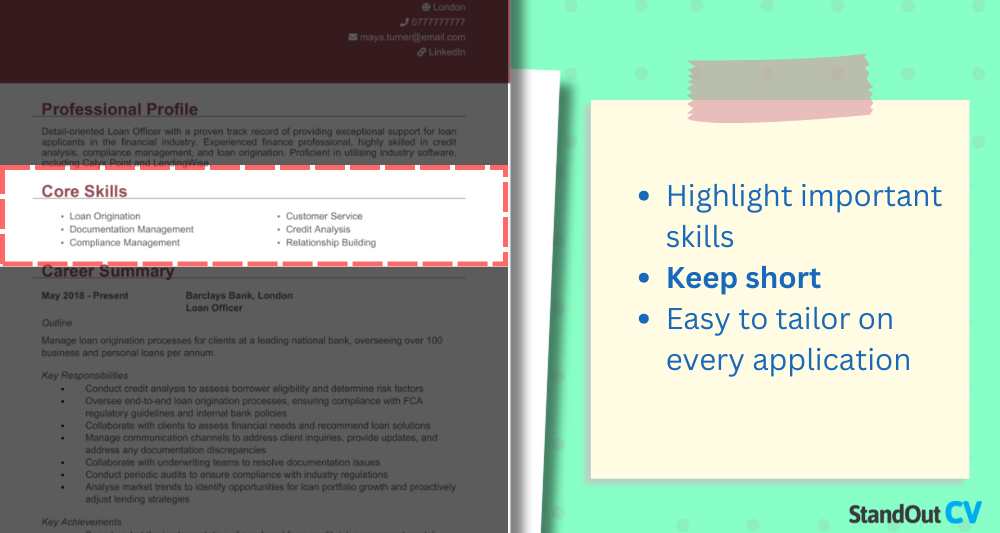

This section should offer a quick overview of your strengths – but it’s not the place to overwhelm with tools and buzzwords. Instead of turning this into a checklist, use it to reinforce the kind of designer you are and the value you bring to a team.
Your CV skills could include your approach to design, familiarity with collaborative workflows, or the kinds of problems you like to solve. Think of it as a snapshot of your perspective, not your entire loadout: keep it all relevant and tailored to the jobs you’re applying for.
Most important skills for Game Design
- Game Concept Development – Creating original game ideas, mechanics, storylines, and characters that align with target audiences.
- Level Design and World Building – Designing engaging game environments, levels, and challenges that enhance gameplay flow and player experience.
- Gameplay Mechanics Design – Developing core game systems such as controls, objectives, progression, and balance.
- Storyboarding and Narrative Design – Writing dialogue, scripts, and story arcs that integrate with gameplay and visual style.
- Prototyping and Playtesting – Building early versions of games, testing mechanics, and refining features based on feedback.
- 2D/3D Asset Integration – Collaborating with artists to implement visual assets within game engines while maintaining performance and style.
- Game Engine Proficiency – Using tools like Unity or Unreal Engine to build, test, and optimise interactive experiences.
- User Interface (UI) and User Experience (UX) Design – Creating intuitive menus, HUDs, and control systems that support gameplay.
- Collaboration with Development Teams – Working closely with programmers, artists, and sound designers to bring the game vision to life.
- Industry Research and Trend Analysis – Studying game trends, player behaviour, and technology advancements to inform design decisions.
Describing your work experience
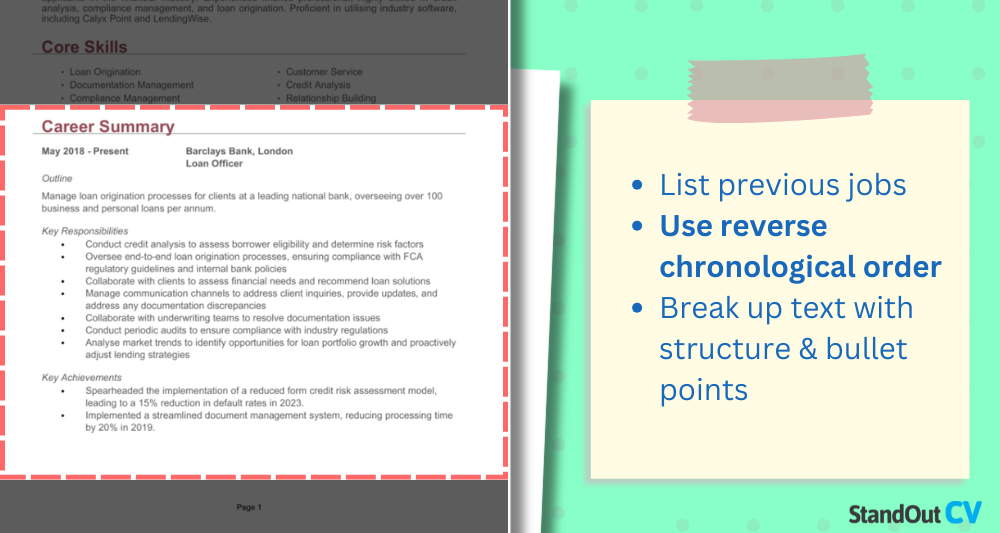
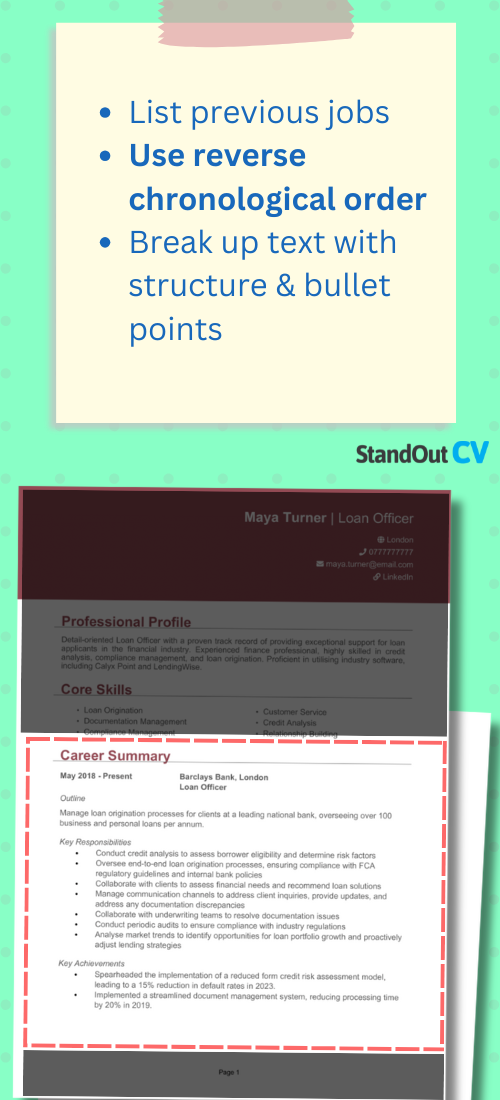
Game studios want to see that you’ve contributed to actual projects – so your work experience section should focus on how you turned ideas into interactive experiences. Whether it’s shipped titles or student games, make your contributions clear and measurable.
List roles in reverse chronological order. For each, include your title, studio name, and dates. Use bullet points to describe your contributions – level layouts, system balancing, prototyping – and include achievements or metrics where possible.
What’s the correct way to structure job history on your CV?
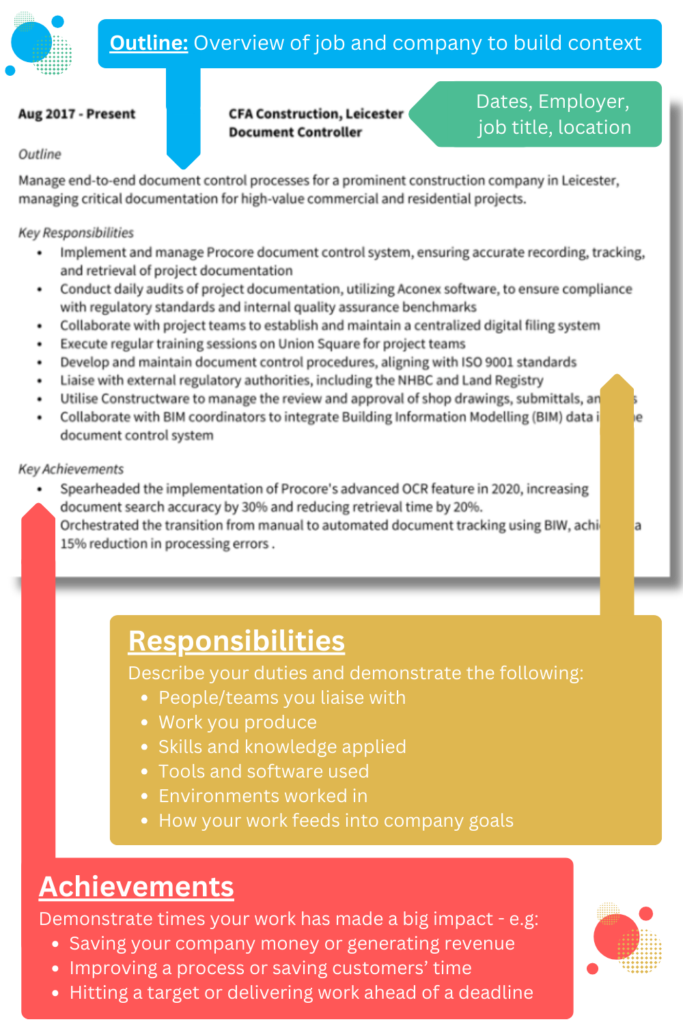
- Outline – Describe the studio, scope of the project, and the nature of your role within the team. This helps the reader quickly understand the context of your work.
- Responsibilities – Focus on what you actively worked on, using action words like “prototyped,” “refined,” “collaborated on,” or “adjusted.” Mention how you contributed to gameplay systems, level flow, or narrative structures.
- Achievements – Show the results of your input – and as a bonus tip, sprinkle in some numbers where possible to make them seem more tangible.
Sample work experience for Game Design
Game Designer | NovaPixel Studios
Outline
Contributed to the design and development of a 2D action platformer for PC, working closely with a multidisciplinary indie team throughout production.
Responsibilities
- Created detailed game design documents outlining mechanics, level flow, and user experience goals.
- Designed and iterated on gameplay levels using Unity, ensuring balance and progression.
- Scripted enemy behaviours and trigger-based events using C#.
- Collaborated with artists and sound designers to align visuals and audio with gameplay moments.
- Tested gameplay internally and incorporated player feedback into revisions.
Achievements
- Helped increase demo engagement by 40% after refining early-level pacing and onboarding.
- Contributed to a successful Kickstarter campaign that surpassed funding goal by 120%.
- Implemented a modular level design system that accelerated development of new content.
Junior Game Designer | HexaPlay Interactive
Outline
Assisted in the development of a puzzle-based mobile game, supporting the senior design team with concepting, asset integration, and gameplay refinement.
Responsibilities
- Brainstormed puzzle concepts and translated ideas into functional prototypes in Unity.
- Balanced in-game economies and difficulty curves based on player metrics.
- Created UI mockups and collaborated with the UI/UX team on menu flows.
- Wrote design notes and presented gameplay pitches during weekly review sessions.
- Participated in QA testing to identify bugs and suggest gameplay improvements.
Achievements
- Reduced player drop-off in early levels by redesigning tutorial flow.
- Awarded internal recognition for creativity and contribution to ideation process.
- Supported live game updates with new level design concepts post-launch.
Freelance Game Designer | Self-employed
Outline
Designed and launched multiple small-scale games for web and mobile as part of a personal portfolio, focusing on narrative, experimentation, and player engagement.
Responsibilities
- Built games using Unity and Godot engines, handling both design and implementation.
- Designed characters, levels, and game mechanics tailored to unique themes.
- Used Trello and GitHub for project tracking, version control, and collaboration.
- Collected user feedback via online platforms and applied it to game iterations.
- Published games to platforms like Itch.io and Google Play.
Achievements
- Achieved over 10,000 combined downloads across three self-published titles.
- Featured in a local indie game showcase for unique storytelling approach.
- Built a strong online portfolio demonstrating end-to-end design capability.
What should your CV’s education section include?
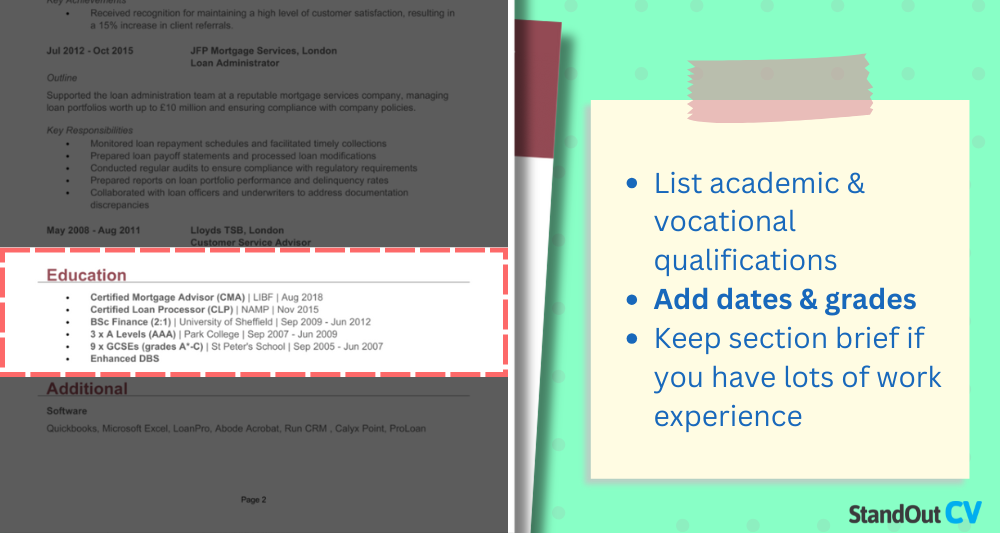

Formal education is valuable, but in game design, your portfolio often says more than your diploma. Still, list your most relevant qualifications – especially game design or computer science degrees.
Also include courses in tools (Unity, Unreal, etc.), certifications (e.g. UX Design), or workshops from recognised providers. If you’ve completed any mentorship programmes, mention those too.
What qualifications do employers look for in Game Design?
- BA/BSc in Game Design, Interactive Media, or Computer Science – Builds essential theory and technical grounding.
- Diploma or Certificate in Game Design (e.g. from Escape Studios, FutureLearn) – Focused, hands-on learning.
- Unity or Unreal Engine Certification – Demonstrates practical experience with major industry tools.
- User Experience (UX) Design Certificate – Enhances interface and player experience understanding.
- Game Jam Awards or Showcased Projects – Adds credibility to practical design experience.


